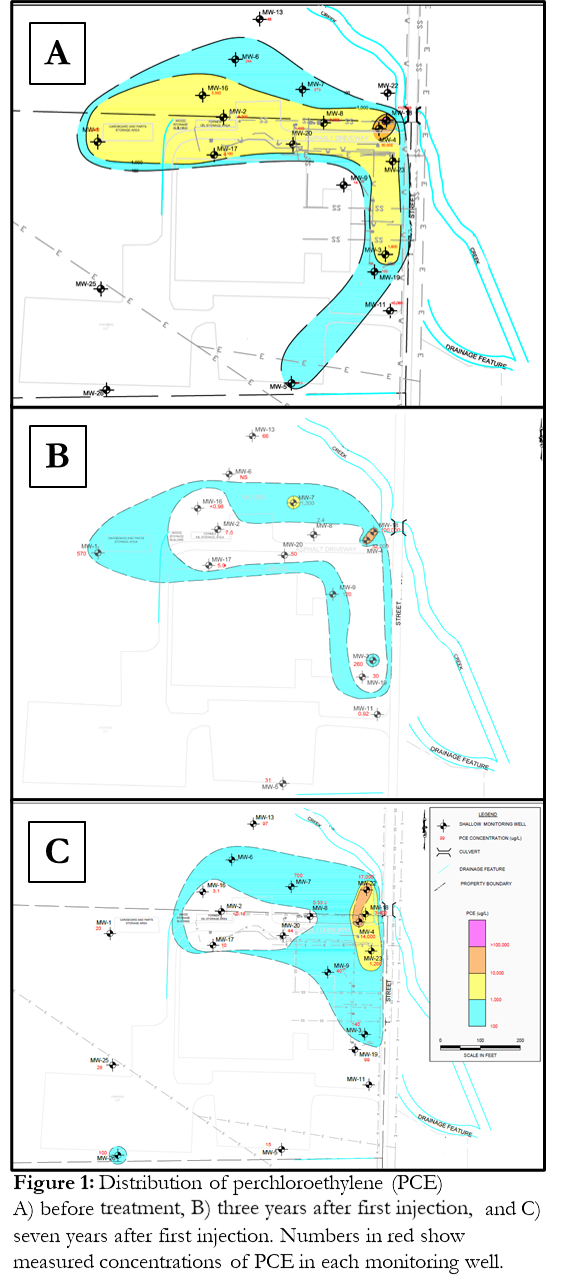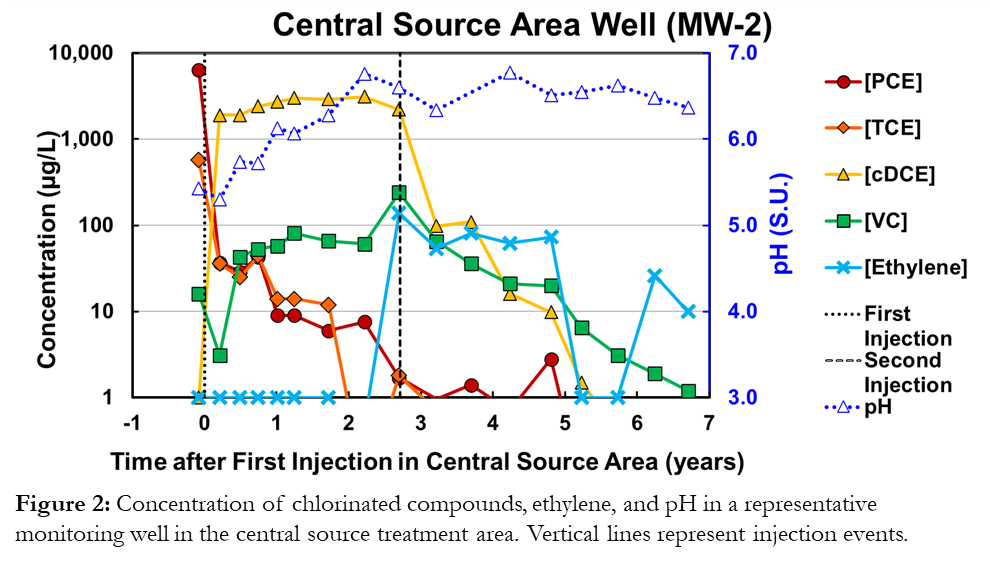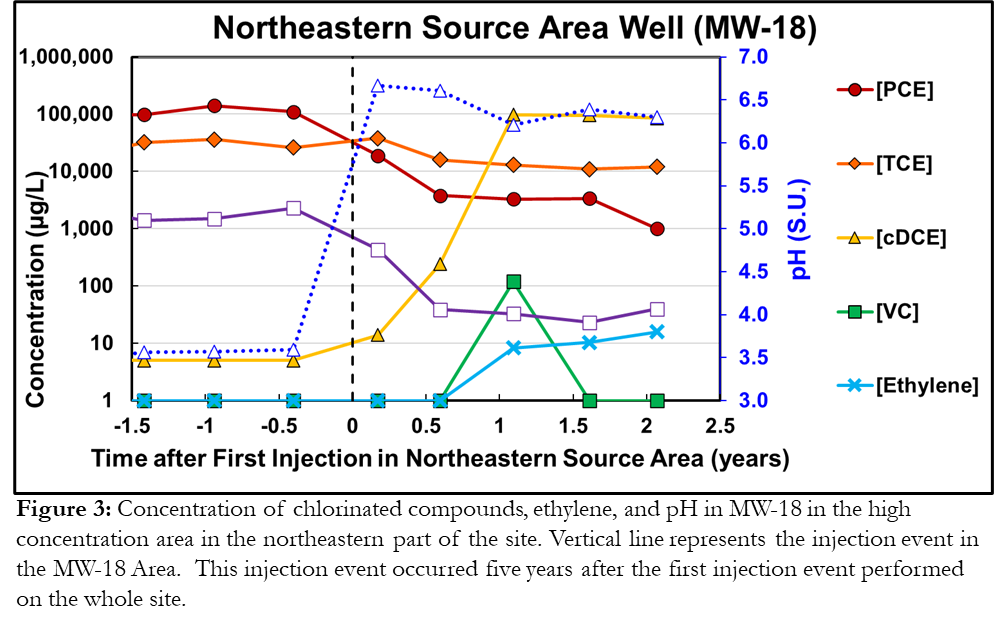Enhanced Reductive Dechlorination at a Challenging Site
Challenge
Despite its effectiveness and low cost to treat chlorinated compounds, enhanced reductive dechlorination is often overlooked as a remediation alternative when unfavorable biological conditions such as low pH and non-detectable microbial activity exist. However, even these sites can be treated successfully and affordably through careful planning using the right amendments.
The soil and groundwater of a former manufacturing site possessed high concentrations of chlorinated compounds. The underlying aquifer consists of unconsolidated sand and gravel (hydraulic conductivity of ~3 ft/day) and is overlain by a clay-rich confining layer. Contaminants migrated along storm and sanitary sewers influencing the plume distribution. Preliminary monitoring confirmed that perchloroethylene (PCE) was the main chlorinated compound of concern, detected at concentrations above 8,000 µg/L (Figure 1A) Other contaminants such as trichloroethylene (TCE) were also present on site at levels above the regulatory standard.
Monitored natural attenuation (MNA) alone was not feasible, and responsible parties questioned if ERD was a feasible option to treat this site due to challenging site conditions including:
- high concentrations of contaminants in the overlying clay-rich confining layer which, because of its low permeability, allows for diffusion of the chlorinated compounds into the underlying sands and gravels;
- low pH (3.2 to 6.5) from a discharge of sulfuric acid from an adjacent site; and
- low numbers of halo-respiring bacteria (<10 cells/mL).

Strategy
Even though the site conditions were challenging for ERD, careful evaluation of potential strategies determined that this technology could still be implemented with the right substrate and amendments. Compared with in situ chemical oxidation (ISCO) and in situ chemical reduction (ISCR), amended bioaugmentation had a lower total cost (Table 1), is safe to handle, and contaminant concentration rebound is not expected. For these reasons, amended bioaugmentation was selected as the remediation strategy.

- EOS® XR, an extended release, emulsified-oil substrate to allow long-lasting ERD and ensure removal of chlorinated compounds that would diffuse from the clay confining layer and
- CoBupH™, a colloidal buffer designed to increase and maintain an optimal aquifer pH for microbial growth throughout remediation.
Results
PCE and TCE rapidly degraded following injection of EOS® XR, CoBupH™, and bioaugmentation with BAC-9 (Figure 1B). Daughter product chlorinated compounds such as cis-dichloroethylene (cDCE) appeared, proving amendment addition stimulated reductive dechlorination (Figure 2). However, further conversion of cDCE to compounds such as ethylene (the non-hazardous end-product of reductive dechlorination) was slow.

Monitoring showed that 1) pH was still below the optimal range for ERD in some areas and 2) concentrations of nutrients such as nitrogen, required for microbial growth, were low.
Bench scale studies and pilot tests on selected wells confirmed that adding these nutrients increased dechlorination rates and produced ethylene. Therefore, the site was amended with the following products:
- EOS® Pro, an emulsified-oil substrate enhanced with the required nutrients (nitrogen, phosphorus, and vitamin B12) to perform complete dechlorination successfully
- And additional colloidal buffer (CoBupH™) to achieve a neutral pH faster and maintain it for longer periods of time.
After this injection event, concentrations of DCE substantially decreased (Figure 2), and ethylene was detected, demonstrating that complete dechlorination was achieved after the second amendment. A stable pH contributed to this achievement, as an optimal value was achieved right after injection of additional CoBupH™ (Figure 2). After seven years, the extent and concentrations of the plume have substantially decreased, proving that sites with similar issues can be treated efficiently with amended bioaugmentation using EOS® Pro, CoBupH™, and BAC-9
Following successful implementation of ERD, an additional area of high contaminant concentrations was discovered on the northeastern part of the site near MW-18.

Elevated concentrations of PCE and TCE (110,000 and 22,000 µg/L, respectively), as well as other co-contaminants such as 1,1,1-trichloroethane (1,1,1-TCA, 37,000 µg/L), were detected. ERD was applied to the MW-18 area using lessons learned on the first treatment area. While treatment in the MW-18 area is ongoing, two years after EOS® Pro, CoBupH™ and BAC-9 application in the MW-18 area (five years after the initial zone treatment), positive ERD results show:
- PCE, TCE, and 1,1,1-TCA concentrations have decreased considerably;
- cDCE and ethylene have steadily been produced; and
- the average pH of this area has been increased from 3.6 to 6.4 and has been optimal and stable (Figure 3), showing that conditions for ERD in terms of substrate and pH are amenable.
Conclusion
Results from this site and many others show that ERD remains a strong option to treat sites in an efficient and affordable way, even when the conditions do not seem favorable for biological growth. EOS® Pro, CoBupH™, and BAC-9 bioaugmentation cultures can provide long-lasting substrate, adequate nutrients, and a pH-optimizing buffer to ensure successful site treatment.
